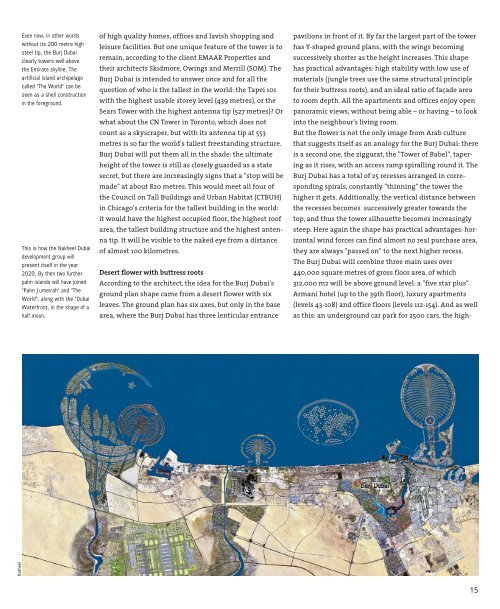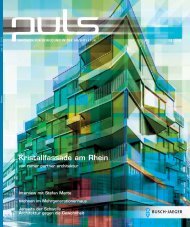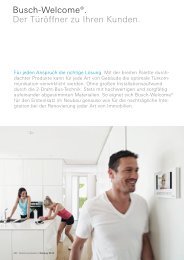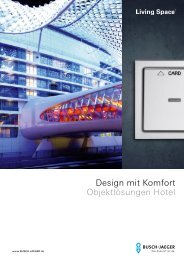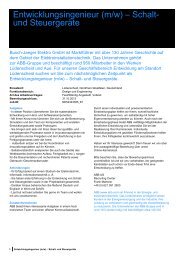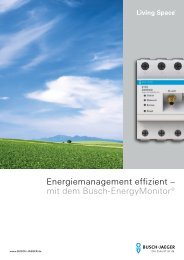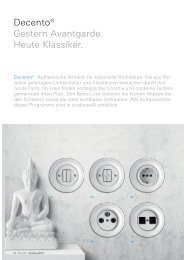The Ultimate Tower – Burj Dubai - Busch-Jaeger Elektro GmbH
The Ultimate Tower – Burj Dubai - Busch-Jaeger Elektro GmbH
The Ultimate Tower – Burj Dubai - Busch-Jaeger Elektro GmbH
Create successful ePaper yourself
Turn your PDF publications into a flip-book with our unique Google optimized e-Paper software.
Nakheel<br />
Even now, in other words<br />
without its 200 metre high<br />
steel tip, the <strong>Burj</strong> <strong>Dubai</strong><br />
clearly towers well above<br />
the Emirate skyline. <strong>The</strong><br />
artificial island archipelago<br />
called "<strong>The</strong> World" can be<br />
seen as a shell construction<br />
in the foreground.<br />
This is how the Nakheel <strong>Dubai</strong><br />
development group will<br />
present itself in the year<br />
2020. By then two further<br />
palm islands will have joined<br />
"Palm Jumeirah" and "<strong>The</strong><br />
World", along with the "<strong>Dubai</strong><br />
Waterfront, in the shape of a<br />
half moon.<br />
of high quality homes, offices and lavish shopping and<br />
leisure facilities. But one unique feature of the tower is to<br />
remain, according to the client EMAAR Properties and<br />
their architects Skidmore, Owings and Merrill (SOM). <strong>The</strong><br />
<strong>Burj</strong> <strong>Dubai</strong> is intended to answer once and for all the<br />
question of who is the tallest in the world: the Tapei 101<br />
with the highest usable storey level (439 metres), or the<br />
Sears <strong>Tower</strong> with the highest antenna tip (527 metres)? Or<br />
what about the CN <strong>Tower</strong> in Toronto, which does not<br />
count as a skyscraper, but with its antenna tip at 553<br />
metres is so far the world's tallest freestanding structure.<br />
<strong>Burj</strong> <strong>Dubai</strong> will put them all in the shade: the ultimate<br />
height of the tower is still as closely guarded as a state<br />
secret, but there are increasingly signs that a "stop will be<br />
made" at about 820 metres. This would meet all four of<br />
the Council on Tall Buildings and Urban Habitat (CTBUH)<br />
in Chicago's criteria for the tallest building in the world:<br />
it would have the highest occupied floor, the highest roof<br />
area, the tallest building structure and the highest antenna<br />
tip. It will be visible to the naked eye from a distance<br />
of almost 100 kilometres.<br />
Desert flower with buttress roots<br />
According to the architect, the idea for the <strong>Burj</strong> <strong>Dubai</strong>'s<br />
ground plan shape came from a desert flower with six<br />
leaves. <strong>The</strong> ground plan has six axes, but only in the base<br />
area, where the <strong>Burj</strong> <strong>Dubai</strong> has three lenticular entrance<br />
pavilions in front of it. By far the largest part of the tower<br />
has Y-shaped ground plans, with the wings becoming<br />
successively shorter as the height increases. This shape<br />
has practical advantages: high stability with low use of<br />
materials (jungle trees use the same structural principle<br />
for their buttress roots), and an ideal ratio of façade area<br />
to room depth. All the apartments and offices enjoy open<br />
panoramic views, without being able <strong>–</strong> or having <strong>–</strong> to look<br />
into the neighbour's living room.<br />
But the flower is not the only image from Arab culture<br />
that suggests itself as an analogy for the <strong>Burj</strong> <strong>Dubai</strong>: there<br />
is a second one, the ziggurat, the "<strong>Tower</strong> of Babel", tapering<br />
as it rises, with an access ramp spiralling round it. <strong>The</strong><br />
<strong>Burj</strong> <strong>Dubai</strong> has a total of 25 recesses arranged in corresponding<br />
spirals, constantly "thinning" the tower the<br />
higher it gets. Additionally, the vertical distance between<br />
the recesses becomes successively greater towards the<br />
top, and thus the tower silhouette becomes increasingly<br />
steep. Here again the shape has practical advantages: horizontal<br />
wind forces can find almost no real purchase area,<br />
they are always "passed on" to the next higher recess.<br />
<strong>The</strong> <strong>Burj</strong> <strong>Dubai</strong> will combine three main uses over<br />
440,000 square metres of gross floor area, of which<br />
312,000 m2 will be above ground level: a "five star plus"<br />
Armani hotel (up to the 39th floor), luxury apartments<br />
(levels 43-108) and office floors (levels 112-154). And as well<br />
as this: an underground car park for 2500 cars, the high-<br />
15


